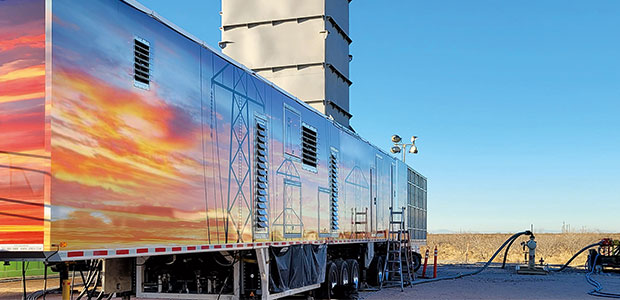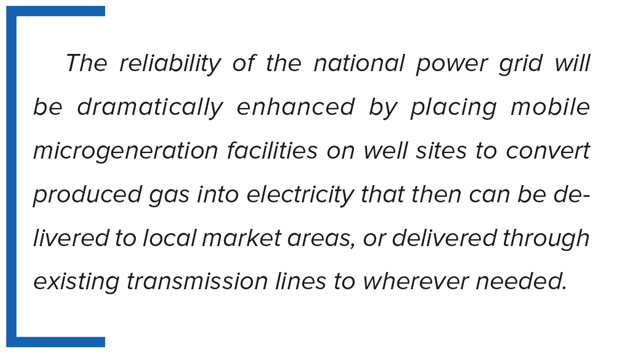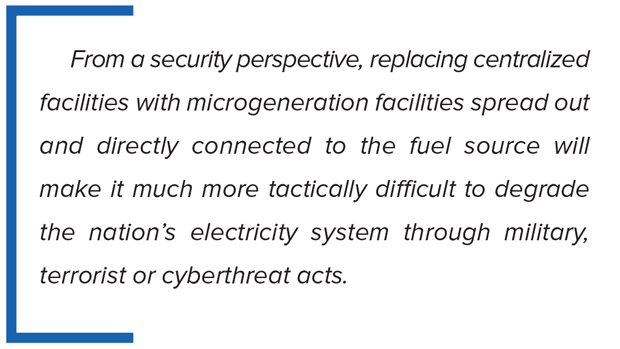
Gas-Fired Microgrids Demonstrate Possibilities Of Rethinking Power System
By Lyoid Fussell
TULSA—The United States is the world’s largest natural gas producer. It only stands to reason that the nation’s huge endowment of clean-burning natural gas resources should represent a foundational cornerstone of any efforts to update and modernize the domestic electricity grid.
Indeed, power generators largely adopted that strategy during the past two decades. While U.S. electric consumption has grown roughly 10% since 2020, the volume of natural gas consumed in electricity generation has effectively doubled during that same period, according to the U.S. Energy Information Administration. As of October 2023, 40% of all utility-scale electricity generation was from natural gas, representing about four times the amount of power generated by wind and 12 times the amount generated by solar.
The grid runs on natural gas, and gas-fired generation has proven itself safe, reliable and efficient. Not only does natural gas have a pivotal role to play in generating power, but it also may hold the key to revolutionizing the grid to operate in a much more distributed, dependable, secure and responsive manner.
Stepping back and looking at the bigger picture, the reality is that the Lower 48 power grid has not undergone major changes in design or functionality in a long while. The source of generation has shifted and capacity has been added, but the general principle remains the same: a source—be it a nuclear reactor, coal-powered steam turbine, gas-powered turbine, wind turbine, hydraulic turbine or photovoltaic cells—generates electricity, which is sent directly to the distribution grid and consumed. Because it is incredibly difficult to store power for later use, the grid must maintain a significant backup of reserve capacity to activate as demand dictates.
As it has since July 13, 1895, when the Folsom Powerhouse in California used hydroelectric AC generators to produce high-voltage electricity and transmit it 35 kilometers to Sacramento, the American power grid is based on a “use it or lose it” scenario. Electricity production and consumption both occur in real time without a storage capacity to buffer either unplanned supply outages or demand surges. At any point in time, the grid only can consume what is being produced, and can really only produce what is being consumed.
That means that despite all the massive technological advances made over the past 130 years, the electricity generated by a power plant still has to be immediately transmitted and consumed or it will be lost. This issue is exacerbated by alternative fuel sources because they have a limited timeframe in which to generate power. After all, a wind turbine only produces power when the wind blows. This issue is universally recognized, of course, and many companies are pursuing more efficient battery solutions to address the fact that peak load times do not necessarily correspond with peak generation times.
In contrast, natural gas can be directly and efficiently converted to electricity at any time of day or night to align peak generation with peak demand. However, a long-term vision of how a natural gas-centered solution ultimately can play out is lacking. It is time to truly think outside the box. Instead of building large centralized power plants and complex, interconnected grids to generate and transmit electricity, what if the entire system were redistributed into smaller parts that act more independently? Rather than building a single massive 300-megawatt gas-fired facility connected to a maze of gas pipelines and electric transmission lines, what if that same capacity can be added in multiple small plants located close to well sites and securely connected to an ultrareliable fuel source?
Distributed Generation
While the concept of “distributed generation” powered by natural gas has been around for some time, in practice, it represents a very small slice of the total domestic power generation pie. The security and reliability of the national power grid will be dramatically enhanced by placing mobile microgeneration facilities on well sites to convert produced gas into electricity that then can be delivered to local market areas, or delivered through existing transmission lines to wherever needed. It will reduce the need for expensive new construction pipeline and power line infrastructure projects, and the generated electricity will be available on call to meet dynamic demand loads.
Microgeneration is a viable potential solution, but it is not a panacea. The small-scale generators used in a distributed system are not inexpensive, but they can be selectively sized based on the forecast amount of available gas supply on site. The downside is that, like any electricity source, a generator only earns revenue when it is generating power. The fact is that the economics of microgeneration do not work if well site facilities are only utilized temporarily for emergency or peak power loading. Mobile generators need to be the primary source of power for this solution to work economically, with the existing centralized facilities on which the grid now relies moving to emergency backup sources.
Therein lies the rub. Transitioning to a gas-fired distributed system requires moving away from the installed base of centralized facilities that are already in service. But this much is beyond dispute: As power demand grows, current available U.S. generation capacity is insufficient to satisfy demand down the road. New facilities will have to be built. The question is, what is the strategic path for reaching the best ultimate outcome?
The answer should include careful consideration of rebuilding the grid to be more robust and compartmentalized by distributing generation among many gas-producing sites. This will streamline infrastructure requirements and enhance reliability by creating substantial redundancies with numerous generating locations across large geographic areas. From a security perspective, replacing centralized facilities with microgeneration facilities spread out and directly connected to the fuel source makes it much more tactically difficult to degrade the nation’s electricity system through military, terrorist or cyberthreat acts.
Turning the potential of a domestic grid supplied by microgenerators into reality requires a major mindset change within both the power industry and government and regulatory circles. It will also need appropriate and feasible financial solutions to help electricity co-ops and producers build microplants as the primary generation sources and begin to convert existing facilities to an emergency usage basis. These discussions should be had for the good and safety of our country, and as a more affordable means in which to pursue grid stability.
‘Alternative’ Market
Analogous to the old oil field line that “the best place to find oil is in an oil field,” the best “alternative” markets for natural gas are likely ones that already exist in some form or fashion. As with U.S. power generation, these markets require repurposing and restructuring to maximize the benefits of a natural gas-based approach. There is certainly no shortage of production flowing into the U.S. gas market. Moreover, producing reservoirs tend to have stable, predictable decline curves that span many years, making it possible to accurately plan a micro plant’s long-term supply needs. They are the gas “storage” fields.
And that brings up another key advantage to this approach: improving the efficiency of how energy is produced and stored. Instead of producing gas to surface, aggregating it, shipping to a central storage field and then reinjecting into the subsurface for future use, why not eliminate a huge percentage of the gas transportation and storage mechanism by converting the gas immediately to electrons and store those? In effect, storing the gas molecules results in an unrealized asset that will not return on the investment until some point in the future when it is removed from the ground, shipped to a generating plant and converted into electrons. Microgeneration allows revenue and investment returns to be realized sooner as opposed to later.
As noted, the obvious major obstacle to this proposition is that it is relatively easy to store gas molecules at scale, but in contrast, very difficult to store the generated electrons. However, instead of accepting the current reality as unyielding truth, alternative methods of energy storage need to be pursued with the same level of commitment as developing alternative fuels. Challenging the most innovative minds to find a better way to store energy may produce results that are hard to even imagine today.
As an example, one simple solution may be geothermal energy storage. The energy produced from the natural gas may be converted to mechanical energy and used to pump fluids into a high-temperature, overpressured formation and stored as potential energy waiting to be opened to a hydroelectric turbine. A few companies already are experimenting with this idea. In the simplest explanation, the mechanical energy is used to raise a weight connected to a fly wheel, and when the power is needed, the weight is dropped, spinning the flywheel and generating the stored electricity.
At first glance, this may not appear to be a viable solution for storing large amounts of power. But perhaps the weight can be massively larger, or the theory can be modified so that instead of displacing a weight, the process displaces a fluid volume and creates hydrostatic pressure. The point is, there are other ways to store electricity other than lithium-ion batteries.
The sky should be the limit for proposing and testing theories in the quest to develop a new generation of energy storage capability. As a nation, we should encourage bright young minds to think differently and challenge them to redefine energy storage in a marketplace of ideas. They are the ones who ultimately will be affected by growing energy demand and shrinking supplies. Taking a road less traveled is what will lead to real innovation.
Self-Sustaining Communities
A grid centered on natural gas-fired microgeneration invariably can lead to changes in how communities and municipal infrastructure are built. The oil and gas industry already is using microgrids running on produced gas to self-power fields and operations with small-scale, in-field infrastructure. That same idea can be extended to power entire communities.
Rather than developing a community outward from a power grid system connected to a substation, why not go the other way and start with the generating resource and build back to the infrastructure to push to the grid instead of pulling from it? In this manner, completely self-sustaining and essentially off-grid communities can be built that enhance infrastructure.
Similarly, this approach may transform the way industrial parks are developed, concentrating on areas where natural gas is stranded or supply is pinched by capacity bottlenecks. Often, those areas with stranded gas production are in rural areas, where market access is constrained by infrastructure capacity.
As a prime industrial complex example, imagine a company looking to construct a new data center. Locally converting an underutilized supply of gas directly to power may be a highly economic proposition. One concern is that data centers require extensive high-speed data connections. The good news is that fiber optic crisscrosses the country along railroad rights of way, and railroad tracks are not an uncommon sight in the proximity of underutilized gas fields in many parts of the country. A solution exists for every challenge, no matter how seemingly big.
For 130 years, the nation’s electricity grid has by and large functioned the same. It has managed to get the job done, so far. But for how much longer? The next energy revolution may not be far away. It seems foolish to ignore the possibilities enabled by America’s most abundant resource—natural gas—in fueling that revolution and solving market challenges to satisfy growing demand for electricity.

Lyoid Fussell is vice president of business development at Houston-based Jereh North American Group, a petroleum equipment manufacturer. Located in Tulsa, he is also co-founder of FW Consulting Power Solutions, which helps identify and secure power generation solutions for projects that convert natural gas to electricity. Fussell has more than two decades of industry experience, previously serving in management and sales roles at Trisun Energy Services, ResMetrics, EcoStim Energy Solutions, Ely and Associates Corp., PetroQuest Energy, Core Laboratories and Halliburton. A U.S. Army veteran, Fussell holds a B.S. in industrial engineering from Kansas State University.
For other great articles about exploration, drilling, completions and production, subscribe to The American Oil & Gas Reporter and bookmark www.aogr.com.








